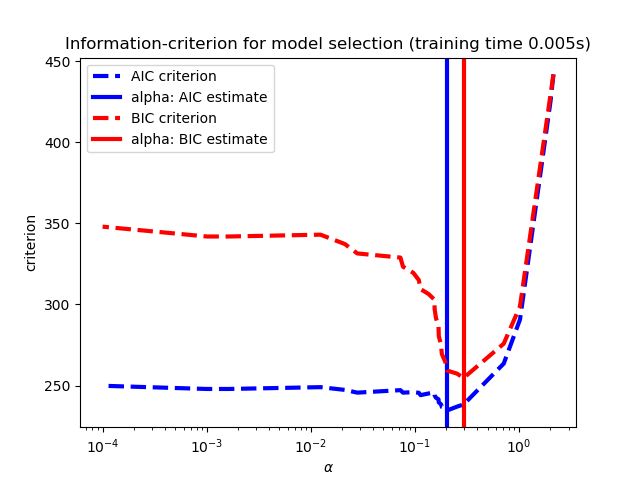sklearn.linear_model.LassoLarsIC¶
class sklearn.linear_model.LassoLarsIC(criterion='aic', *, fit_intercept=True, verbose=False, normalize=True, precompute='auto', max_iter=500, eps=2.220446049250313e-16, copy_X=True, positive=False)
使用BIC或AIC进行模型选择的Lars拟合套索(Lasso)模型
Lasso的优化目标是:
AIC是Akaike信息标准,而BIC是Bayes信息标准。通过在拟合优度和模型复杂度之间进行权衡,这样的标准对于选择正则化参数的值很有用。一个好的模型应该在简单的同时很好地解释数据。
在用户指南中阅读更多内容。
| 参数 | 说明 |
|---|---|
| criterion | {‘bic’ , ‘aic’}, default=’aic’ 要使用的标准类型。 |
| fit_intercept | bool, default=True 是否计算该模型的截距。如果设置为false,则在计算中将不使用截距(即数据应已中心化)。 |
| verbose | bool or int, default=False 日志详细程度。 |
| normalize | bool, default=Falsefit_intercept设置为False 时,将忽略此参数。如果为True,则在回归之前通过减去均值并除以l2-范数来对回归变量X进行归一化。如果你希望标准化,请先使用 sklearn.preprocessing.StandardScaler,然后调用fit 估算器并设置normalize=False。 |
| precompute | bool, ‘auto’ or array-like , default=’auto’ 是否使用预先计算的Gram矩阵来加快计算速度。Gram矩阵也可以作为参数传递。 |
| max_iter | int, default=500 要执行的最大迭代次数。可用于提前停止。 |
| eps | float, optional Cholesky对角因子计算中的机器精度正则化。对于病态系统,请增加此值。与某些基于迭代优化的算法中的 tol参数不同,此参数不控制优化的容忍度。默认情况下,使用np.finfo(np.float).eps。 |
| copy_X | bool, default=True 如果 True,将复制X;否则X可能会被覆盖。 |
| positive | bool, default=False 将系数限制为> =0。请注意,你可能希望删除默认设置为True时的fit_intercept。在正约束下,对于较小的alpha值,模型系数将不会收敛到普通最小二乘解。通常,逐步Lars-Lasso算法所达到最小alpha值(当fit_path = True, alphas_[alphas_ > 0.].min())的系数才与坐标下降Lasso估计的解一致。因此,使用LassoLarsIC只对期望达到稀疏解的问题有意义。 |
| 属性 | 说明 |
|---|---|
| coef_ | array-like of shape (n_features,) 参数向量(公式中的w) |
| intercept_ | float 决策函数中的截距。 |
| alpha_ | float 信息标准选择的alpha参数 |
| n_iter_ | int lars_path运行以查找alpha网格的迭代次数。 |
| criteria_like | array-like of shape (n_alphas,) 所有Alpha信息标准(“ aic”,“ bic”)的值。选择具有最小信息标准的alpha。该值比Eqns. 2.15和2.16中的 n_samples大1倍(Zou et al, 2007)。 |
另见
注
自由度数的估计为:
“On the degrees of freedom of the lasso” Hui Zou, Trevor Hastie, and Robert Tibshirani Ann. Statist. Volume 35, Number 5 (2007), 2173-2192.
https://en.wikipedia.org/wiki/Akaike_information_criterion https://en.wikipedia.org/wiki/Bayesian_information_criterion
示例
>>> from sklearn import linear_model
>>> reg = linear_model.LassoLarsIC(criterion='bic')
>>> reg.fit([[-1, 1], [0, 0], [1, 1]], [-1.1111, 0, -1.1111])
LassoLarsIC(criterion='bic')
>>> print(reg.coef_)
[ 0. -1.11...]
方法
| 方法 | 说明 |
|---|---|
fit(X, y[, copy_X]) |
使用X,y作为训练数据拟合模型。 |
get_params([deep]) |
获取此估计量的参数。 |
predict(X) |
使用线性模型进行预测。 |
score(X, y[, sample_weight]) |
返回预测的确定系数R ^ 2。 |
set_params(**params) |
设置此估算器的参数。 |
__init__(standard ='aic',*,fit_intercept = True,verbose = False,normalize = True,precompute ='auto',max_iter = 500,eps = 2.220446049250313e-16,copy_X = True,positive = False )
初始化self, 请参阅help(type(self))以获得准确的说明。
fit(X, y, copy_X=None)
[源码]
使用X,y作为训练数据拟合模型。
| 参数 | 说明 |
|---|---|
| X | array-like of shape (n_samples, n_features) 训练数据。 |
| y | array-like of shape (n_samples,) 目标值。如有必要,将强制转换为X的数据类型 |
| copy_X | bool, default=None 如果设置了此参数,它将覆盖实例创建时选择的copy_X。如果 True,X将被复制;否则X可能会被覆盖。 |
| 返回值 | 说明 |
|---|---|
| self | object 返回估计器实例 |
get_params(deep=True)
获取此估计量的参数。
| 参数 | 说明 |
|---|---|
| deep | bool, default=True 如果为True,则将返回此估算器和所包含子对象的参数。 |
| 返回值 | 说明 |
|---|---|
| params | mapping of string to any 参数名称映射到其值。 |
predict(X)
[源码]
使用线性模型进行预测。
| 参数 | 说明 |
|---|---|
| X | array_like or sparse matrix, shape (n_samples, n_features) 样本数据 |
| 返回值 | 说明 |
|---|---|
| C | array, shape (n_samples,) 返回预测值。 |
score(X, y, sample_weight=None)
[源码]
返回预测的确定系数R ^ 2。
系数R ^ 2定义为(1- u / v),其中u是残差平方和((y_true-y_pred)** 2).sum(),而v是总平方和((y_true- y_true.mean())** 2).sum()。可能的最高得分为1.0,并且也可能为负(因为该模型可能会更差)。一个常数模型总是预测y的期望值,而不考虑输入特征,得到的R^2得分为0.0。
| 参数 | 说明 |
|---|---|
| X | array-like of shape (n_samples, n_features) 测试样本。对于某些估计量,这可以是预先计算的内核矩阵或通用对象列表,形状为(n_samples,n_samples_fitted),其中n_samples_fitted是用于拟合估计器的样本数。 |
| y | array-like of shape (n_samples,) or (n_samples, n_outputs) X的真实值。 |
| sample_weight | array-like of shape (n_samples,), default=None 样本权重。 |
| 返回值 | 说明 |
|---|---|
| score | float 预测值与真实值的R^2。 |
注
调用回归器中的score时使用的R2分数,multioutput='uniform_average'从0.23版开始使用 ,与r2_score默认值保持一致。这会影响多输出回归的score方法( MultiOutputRegressor除外)。
set_params(**params)
[源码]
设置此估计器的参数。
该方法适用于简单的估计器以及嵌套对象(例如管道)。后者具有形式为 <component>__<parameter>的参数,这样就可以更新嵌套对象的每个组件。
| 参数 | 说明 |
|---|---|
| **params | dict 估计器参数。 |
| 返回值 | 说明 |
|---|---|
| self | object 估计器实例。 |





